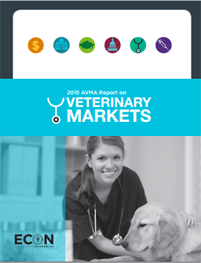(SCHAUMBURG, Illinois) Jan. 20, 2015 – The American Veterinary Medical Association (AVMA) today launched its 2015 Economic Report subscription series, bringing some of the most current and vitally important veterinary economics information to its members and the general public.
 The first installment of the six-part series, the AVMA Report on Veterinary Markets, recaps the AVMA’s 2014 Economic Summit held in October and provides data and information about general U.S. economic conditions, the markets for veterinary education, veterinarians and veterinary services, and workforce capacity utilization.
The first installment of the six-part series, the AVMA Report on Veterinary Markets, recaps the AVMA’s 2014 Economic Summit held in October and provides data and information about general U.S. economic conditions, the markets for veterinary education, veterinarians and veterinary services, and workforce capacity utilization.
“This information is critical to all of us if we are going to have informed, authoritative discussions about the state of the veterinary markets,” said AVMA President Dr. Ted Cohn, a private practitioner from Denver, Colo. “This series of six reports on the many facets of veterinary economics will help veterinarians better understand the markets they operate in and the factors that affect their livelihood. We think it’s a must-have for anyone with a stake in the profession’s overall success.”
The AVMA Report on Veterinary Markets now can be purchased online from the AVMA Store as part of a six-installment series, and a free summary of the current report is also available on the AVMA website. The price for the series is $249 for AVMA members and $499 for nonmembers. The five other reports will be available upon publication. The reports and their scheduled publication dates are:
- The AVMA Report on Veterinary Markets (January)
- The AVMA Report on Veterinary Employment (February)
- The AVMA Report on Veterinary Debt and Income (March)
- The AVMA Report on the Market for Veterinarians (May)
- The AVMA Report on Veterinary Capacity (July)
- The AVMA Report on the Market for Veterinary Education (September)
“These reports are the result of intensive surveying and research by staff members in our AVMA Economics Division, but we couldn’t have done it without the help of our members and other key partners who provided us with valuable information and insight,” Cohn said. “No other group has studied the veterinary workforce to the extent we have. No one has ever produced this type of data.”
Here’s a brief summary of what each report explores:
- The AVMA Report on Veterinary Markets: Provides data and information about general U.S. economic conditions, the markets for veterinary education, veterinarians and veterinary services, and workforce capacity utilization.
- The AVMA Report on Veterinary Employment: We surveyed veterinarians across the country and across the profession to better understand employment, unemployment and underemployment, as well as the factors affecting each.
- The AVMA Report on Veterinary Debt and Income: This report takes an in-depth look at salaries for new and existing veterinarians and their veterinary education debt load, as well as debt-to-income ratios and the net present value of a veterinary career.
- The AVMA Report on the Market for Veterinarians: Ever wonder where the 100,000-plus veterinarians are located, what type of work they do or how much they are compensated? This report explores the demographics of the profession.
- The AVMA Report on Veterinary Capacity: This report includes our excess capacity forecast and explores our capacity utilization survey, descriptive statistics for capacity utilization and the factors affecting capacity utilization.
- The AVMA Report on the Market for Veterinary Education: The market for veterinary education is the beginning of the pipeline to the market for veterinary services. This report looks at the types of students applying to veterinary school, and the supply of and demand for veterinary education.
“For the past few years, the AVMA has been laying the groundwork necessary to allow us to pursue solutions to economic issues facing the veterinary profession,” said AVMA Economics Director Michael Dicks, PhD. “This series of reports is just the beginning of our efforts to help ensure adequate access to veterinary services and the economic viability of the veterinary medical profession.”
# # #

